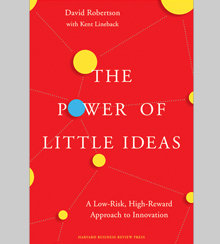A Goldilocks approach to innovation
Wharton professor David Robertson defines a “Third Way” of creating new products and services.
The Power of Little Ideas: A Low-Risk, High-Reward Approach to Innovation
by David C. Robertson with Kent Lineback, Harvard Business Review Press, 2017
In 2008, when Nike executive Sarah Robb O’Hagan was tapped to lead Gatorade, the sports drink’s sales were in decline and it was losing market share to its principal rival, Powerade. She couldn’t turn to incremental innovation: Pursuing the tried-and-tested strategy of adding flavors and low-calorie options to the Gatorade portfolio had already run its course, and was not yielding returns. The idea of blowing up one of PepsiCo’s billion-dollar brands and the organization behind it in a bid for radical reinvention was too risky.
What did Robb O’Hagan do? Taking a page from Nike’s playbook, she refocused the company’s attention — and more meaningfully, its product development and marketing budgets — on Gatorade’s core customers: the serious athletes, young and old, who accounted for 46 percent of sales. Then, she began introducing new hydration and nutrition products designed particularly for that core group. Gatorade introduced a series of gels, bars, and protein shakes that complemented the sports drink and drove its sales, instead of cannibalizing demand for it.
“The innovations were diverse, targeted a specific set of customers, and posed little strategic risk,” writes Wharton School professor of practice David Robertson, author, with Kent Lineback, of The Power of Little Ideas. The new products also reversed Gatorade’s sales slide. By 2015, Gatorade, with sales of US$5.6 billion, owned 78 percent of the U.S. market for sports drinks, about four times Powerade’s 19 percent share.
Robertson compellingly argues that there is something missing in the innovation tool kits of most companies. Companies may think too small, by pursuing innovations that simply yield new and improved versions of their existing products. Or they may think too big, seeking radical innovations that disrupt markets or pursuing entirely new ones, so-called blue oceans. What they are missing, says Robertson, is the just-right alternative of complementary innovation.
Complementary innovation is distinguished by three features. First, it consists of multiple, diverse innovations involving a central product or service that are aimed at making it more appealing. Second, the new innovations work together to satisfy a compelling customer proposition. And third, the resulting family of product innovations are closely and centrally managed.
Robertson points to Disney as a pioneer of complementary innovation. When it got started nearly a century ago, animated films were its core product. But Walt Disney developed a range of innovations — merchandise, Mickey Mouse Clubs, theme parks, and television programming — all aimed at driving more families into theaters and deepening engagement. Over time, these innovations became significant businesses in their own right. (You may remember longtime Disney CEO Michael Eisner talking about complementary innovation as “synergy” back in the 1990s when he and Frank Wells rescued the company from its extended post-Walt malaise.)
There is undeniable value in giving this kind of innovation a name and defining a framework for pursuing it.
Robertson reframes another familiar success story as a tale of complementary innovation. The conventional storyline surrounding Steve Jobs and Apple focuses on the company’s evolution into a serial disrupter. Robertson considers it from a slightly different angle. He views the iMac computer as the company’s core product — the center of what Jobs called a “digital hub.” To support iMac sales, and to give core iMac users more to do with their computer, Jobs launched the iPod, iTunes, Apple Stores, and a variety of software products. Only later, after the phenomenal success of the iPod and iTunes, did the Apple story become one of disruptive innovation, he says.
The Power of Little Ideas is chock-full of cases and core ideas — such as synergy and customer experience — that you’ve likely heard before, but that you’ve probably never seen framed in quite this way. And Robertson puts so much effort into differentiating and positioning complementary innovation as the “Third Way” that I feared it might not live up to its billing as a rare and distinct form of innovation.
But there is undeniable value in giving this kind of innovation a name and defining a framework for pursuing it. Robertson presents that framework in the form of four questions whose answers require that management make both strategic and tactical decisions.
• What is your key product? “It should be one of your crown jewels,” says Robertson. “A key product must be a product that is fairly stable; that is, unlikely to change significantly in the medium term — the next, say, three to five years.”
• What is your promise for your key product? The author defines this as “a commitment to solve a pressing problem or fulfill an unmet need for the customer.”
• How will you innovate around your key product? “Here you identify the specific, tangible innovations that fulfill the promise you’ve chosen,” writes Robertson.
• How will you deliver the innovation? “The first step is to identify who will be responsible for each innovation,” Robertson explains. “The second step is to decide how you will manage these diverse people and groups, that is, what organizational roles and practices will be necessary.”
Anyone charged with growing a company should know the answers to these questions— no matter what kind of innovation they plan to pursue.
Author profile:
- Theodore Kinni is a contributing editor at strategy+business. He also blogs at Reading, Writing re: Management.




